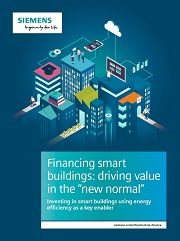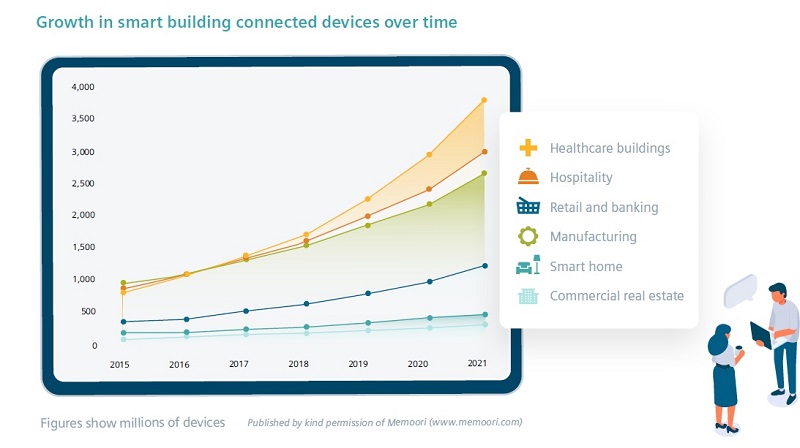The creation of ‘smart buildings’ will be key to the NHS meeting tough new carbon reduction targets in a post-COVID world, says a new report.
Siemens Financial Services (SFS) has released a new insight study which estimates the cost of official building energy conversion targets to 2040 in five sectors – offices; hospitals; manufacturing; public buildings; and education – across 14 countries, including the UK.
These include hospitals, where the cost is estimated to be in the region of $14.4 billion around the world.
The report states: “It is widely accepted that smart buildings add value by delivering agility and flexibility in the ‘new normal’.
“Only smart buildings can fully support returning occupants in the face of myriad pressures including hygiene, safety and environmental regulations.”
Smart technology helps transform the building from a cost burden to an active contributing partner in running a public-sector organisation and coping with the ‘new normal’
And, in a budget-constrained healthcare environment, the paper, entitled Smart buildings: driving value in the ‘new normal’, identifies energy efficiency savings as the ideal starting point for smart buildings transformation, either as a single investment or as a series of incremental projects.
Smart buildings are defined as those which utilise modern technology to improve efficiency and add value.
For example, they enable personalised workspaces where temperature and lighting can be individually controlled; and provide remote fire and security protection and touchless access permission tools.
In healthcare settings they can also digitise cleaning routines triggered by occupancy and the flow of people to maximise space availability; and enable touchless controls for hygiene and infection control, including toilets, hot water, lighting, ventilation and lifts, for example.
According to the European Commission report on Macroeconomic and Other enefits of Energy Efficiency: ‘a smart, higher-performing building can conservatively add as much as 11.8% in lease value and can ultimately yield 5%-35% higher sales values.”
And, one industry commentator, told the report authors: “The smart buildings industry has a massive maret opportunity ahead of it.
In hospitals, smart, adaptive building systems can provide ideal conditions for patient recovery
“In 2020 only 17% of companies are presently operating smart building policies and, of those 22% indictae they will increase the budget for smart building technologies over the next three years.”
But, particuarly for UK healthcare organisations, finance will be key; and the report outlines two approaches to funding the necessary energy-efficiency measures that will be needed to meet the Government’s target of net-zero carbon emissions by 2040.
Option One is Building efficiency as a Service (BEaaS).
This approach covers whole-building and multi-building projects.
An integrated solutions provider introduces technology and systems to create smart buildings which deliver a clearly-predictable level of energy savings.
The reduction in energy costs is then harnessed to effectively fund the cost of building conversion.
While the level of energy reduction will vary, depending on external climate, cost of power, and other factors; in most cases the savings can be reliably reflected in a financing structure to deliver self-financing smart building upgrades.
And, at the end of the agreed financing period, the building owner benefits from the ongoing reduced energy consumption, along with all the other added benefits of smart buildings.

The new report covers five sectors in 14 countries
And building owners do not have to put no capital at risk.
The report states: “In the post-pandemic period, where cash reserves have been used up and revenues are experiencing a downturn; the idea of self-financing smart building conversion becomes even more compelling than before the crisis.”
Or organisations can opt for a second financing option, covering smaller, incremental projects and offering the advantage of being able to spread conversion costs over a specific financing period – managing cash flow by aligning expenditure with the rate of energy savings.
The report explains: “The building technology products which make energy efficiency and smart capabilities possible come to market through a supply chain of distributors, value-added partners (VAPs), solution builders, and engineering, procurement and construction (EPC) companies.
“Where the solution provider has teamed up with an expert financier who understands the technology, its applications, and its benefits then financing arrangements – often based on leasing structures – can be tailored to fit the organisation’s precise cashflow profile, aligning costs with the rate of benefits and/or savings gained.”

Healthcare buildings, in particular are seeing a growth in smart building connected devices. (figures show millions of devices) Image courtesy of Memoori
Secondly, integrated forms of sales finance are a key part of the value proposition, providing clients with staged payments that ease cas flow and make it easier to make investment decisions.
For larger sales, the techniques are usually lease based, whereas smaller product transactions might come with an extended payment term offer embedded.
In the post-pandemic period, where cash reserves have been used up and revenues are experiencing a downturn; the idea of self-financing smart building conversion becomes even more compelling than before the crisis
The report states: “In hospitals, smart, adaptive building systems can provide ideal conditions for patient recovery by leveraging artificial intelligence to optimise temperature, air quality and flow – vital for infection control – lighting and other variables within patient rooms as well as optimising energy consumption.”
Commenting on the publication, Mark McLoughlin of SFS adds: “The way official buildings are used has shifted dramatically across sectors in the last year.
“Owners need to invest now to make buildings safe and suitable for occupants, but they should also consider how smart finance solutions, alongside smart technologies, can improve the underlying operational cost base of their assets in the long term.”
“Smart buildings deploy automated and digitaliesd technology to enable more-efficient, more-effective building capabilities and management.
“And the data generated by IoT sensors provides real-time information for quick reactions.
“Smart technology helps transform the building from a cost burden to an active contributing partner in running a public-sector organisation and coping with the ‘new normal’.”
